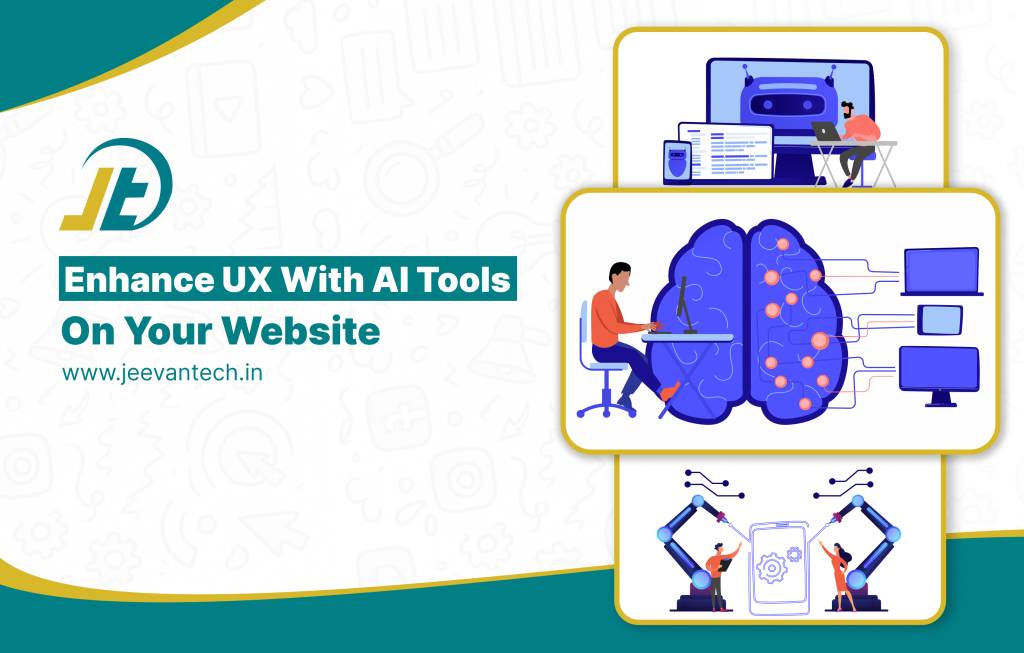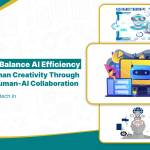Introduction
As digital expectation rises, organizations are seeking new ways to create an interactive and seamless personalized website. Integrating AI tools in UX design is transforming how websites interact with visitors, paving the way for smarter experiences and enhanced results.
By leveraging AI tools, businesses can learn user behaviors, personalize content in real time, and deliver highly intuitive journeys. This revolution in user engagement ensures that websites not only look great but also function intelligently, providing users with meaningful and efficient interactions
This blog explores how to improve website UX with AI, the powerful tools available, and best practices for leveraging AI for User experience.
Understanding AI for User Experience:
Definition and key UX components
User Experience(UX) refers to the overall journey and satisfaction users have encountered while interacting with a digital product. Excellent UX ensures visitors find your site intuitive, engaging and valuable– whether making purchases, accessing information or simply exploring your content.
How AI tools are revolutionizing UX?
The introduction of Artificial Intelligence(AI) is reshaping how businesses approach and optimize UX. Today’s advanced AI tools directly influence nearly every aspect of website design and user interaction, making digital experiences smarter and faster.
1. From personalised to predicted analysis
- AI enables deep UX optimization by analyzing user data in real-time and customizing experiences for each visitor. Instead of a one-size-fits-all site, Artificial Intelligence personalized recommendations, content, and navigation based on individual behaviors and preferences.
- For example, AI- powered e-commerce sites display products users are most likely to buy. While news sites tailor article suggestions to personal interests.
2. Real-time user behaviour analysis with AI tools
Modern AI tools aren’t static; they constantly learn and adapt. By collecting real-time data– such as clicks, scrolls and time-on-page. AI identifies and immediately responds with user actions.
Example:
- AI- powered chatbots update their responses based on ongoing user conversations.
- AI heatmap and analytic tools instantly alert designers about underperforming elements and guides with improvements needed.
Key AI Tools that Improve Website UX:
AI- based user experience is reshaping how websites interact with users, offering smarter, faster and more customized experiences. By integrating cutting-edge AI-tools, businesses achieve deeper UX optimization– boosting engagement, conversion rate and satisfaction.
Chatbots and virtual assistance with AI tools
AI- powered chatbots and virtual assistance provide instant, human-like interactions on websites, guiding users, answering queries and streamlining customer support.
- ChatGPT, Copilot, Claude:
Industry- leading conversational AI platforms that offer natural dialogue, support multiple languages and integrate with digital channels.
- Voiceflow, SnatchBot:
Enable easy design, deployment and integration chatbots across web and messaging platforms without extensive coding.
- Rasa:
Flexible platform for building customizable conversational AI experiences for enterprises.
AI tools for personalization engines
Personalization engines use machine learning to craft content, recommendations and layouts to individual users.
- Dynamic Yield: Delivers customized product, content and offers recommendations based on user behaviour in real time.
- IBM AI Personalization: Segments audiences and adapts messaging dynamically using user’s preferences and engagement patterns.
AI heatmaps and session replay tools
AI-powered heatmaps and session replay tools visualize exactly how users interact with your site, highlighting navigation paths and click zones–vital for continuous UX enhancement.
- Hotjar: Industry standard for heatmaps, click tracking, surveys and session recordings with AI analytics to summarize user feedback and pain points.
- FullStory: Advanced session replays and AI-driven insights, automatically surfacing user frustrating indicators and conversion barriers.
AI tools for predictive UX design
Predictive UX design leverages AI algorithms to anticipate user needs, recommend improvements and automate design choices– leading to faster iterations and more effective user experiences.
- Galileo AI: Suggests dynamic design improvements, analyzes user flows and provides real-time recommendations for designers.
- Neurons Predict AI: Uses vast eye- tracking datasets to generate predictive heatmaps and forecast user reactions–enables designers to optimize layouts before launch.
How to Implement AI Tools for Better UX:
Integration of AI into UX has been transforming how websites engage users, providing smarter and more intuitive interactions. This practical procedure explores key approaches for deploying AI-based UX design, driving a Personalized UX Experience powered by AI-driven Data, Predictive tools and emerging trends like Voice Search and automated UX optimization.
Analyzing user behaviour with AI tools
Leverage Behavioral Analytics: Use AI- powered analytics platforms to collect and interpret large volumes of user interaction data, such as click paths, dwell time and conversion points.
Personalizing user experience
Dynamic Content Delivery: AI personalization engines tailor site content, offers and navigation to individuals for a more personalised experience.
Optimizing design and prototyping
AI-Assisted Design Tools: Use solutions like Galileo AI or Uizard to automatically generate and optimize wireframes, rapidly producing prototypes that reflect user needs and behaviours.
Enhancing UX copy and accessibility
Natural Language Generation: AI- based copywriting tools like Jasper.ai, Copy.ai craft clear, personalized messaging that resonates with distinct audience segments.
Automating A/B Testing and UX experiments
AI-Powered A/B Testing: Use predictive analysis and automated experimentation tools to test multiple variables simultaneously. AI systems can instantly interpret outcomes, suggest winning designs and roll out improvements across user segments.
Continuous UX Optimization: Set up feedback loops that use live user data to refine interface elements, copy and workflows in real time for ongoing improvement.
Benefits of Using AI for UX:
Artificial Intelligence(AI) is revolutionizing User Experience(UX) by creating faster, smarter and more interactive interactions on digital platforms. Incorporating AI into UX design brings multiple key benefits that positively impact both users and businesses.
Here’s a focused look at the major advantages, emphasises the inclining engagement, faster interactions and enhanced accessibility.
Increased Engagement
AI-driven predictive tools analyze user behavior and preferences in real- time to deliver highly personalized experiences tailored to individuals needs. In an evolving manner adjusting content, product recommendations or navigation paths. AI keeps users interested and immersed longer, leading to higher interaction rates and better conversion.
Faster Interactions
AI also enhances UX responsiveness by streamlining user journeys and reducing friction points. Tools like voice search allow users to quickly find information or perform actions hands-free, speeding up task completion and making location seamless, especially on mobile or multitasking scenarios.
Enhances Accessibility
AI dramatically extends its accessibility of digital experiences for users from various abilities. Automated accessibility checks and AI-driven features like voice input, speech-to-text, and dynamic content adjustments make websites more usable for everyone.
Challenges and Ethical Concerns:
AI-driven technologies are rapidly transforming digital experiences, but their integration brings a set of complex challenges and ethical concerns. As AI algorithms automate user decisions, which is vital to examine how these innovations intersect with issues like privacy, bias or user autonomy.
Bias and Fairness
- AI Algorithms may inadvertently reinforce or amplify social biases present in their training data, leading to unfair or discriminatory outcomes.
- A biased AI system might affect everything from content recommendations to validating features, limiting equal access or representation.
- Ensuring fairness requires regular audit and refinement of algorithms, inclusion of diverse datasets and transparent criteria for automated decisions.
Privacy and Security
- The use of AI-driven automation often involves gathering and analysing vast amounts of user data, raising distinctive privacy risks.
- Encryption and robust security protocols are important to protect sensitive information from breaches, leaks or misuse.
Transparency
- Lack of transparency undermines trust. Users might not know why they are shown certain content or recommendations by AI- powered platforms.
- Enhancing transparency involves clear algorithmic explanations, open documentation and user-facing disclosures about AI-driven processes.
User Autonomy and Control
- Giving users clear options to override, adjust or opt out of AI- powered features is vital to maintain trust and satisfaction.
- Meaningful user consent and easy-to-use privacy settings are essential for upholding autonomy in automated systems.
Social Manipulation and Misinformation
- Social manipulation– like targeted persuasion and micro-targeted political ads. They tend to raise ethical questions about the influence of AI-powered platforms on public opinion and behaviour.
- Addressing this risk requires content moderation, in fact checking mechanisms and ethical guidelines for deploying automation in information-sensitive contexts.
Building the Future of UX with AI:
- Are you looking for a long stay in digital space?, enhancing your website’s user experience is a necessity. With the rise of Artificial intelligence designing and automation, AI- based UX design services in coimbatore are becoming a powerful tool to create personalized and interactive digital journeys.
- By joining hands with JeevanTech’s website user experience experts where brands can utilize advanced tools and insights to optimize every touchpoint. Whether you are aiming to brush-up UX for your business website or invest in AI website enhancement, the goal remains the same.i.e., creating a responsive, interactive and delightful experience for your users.






